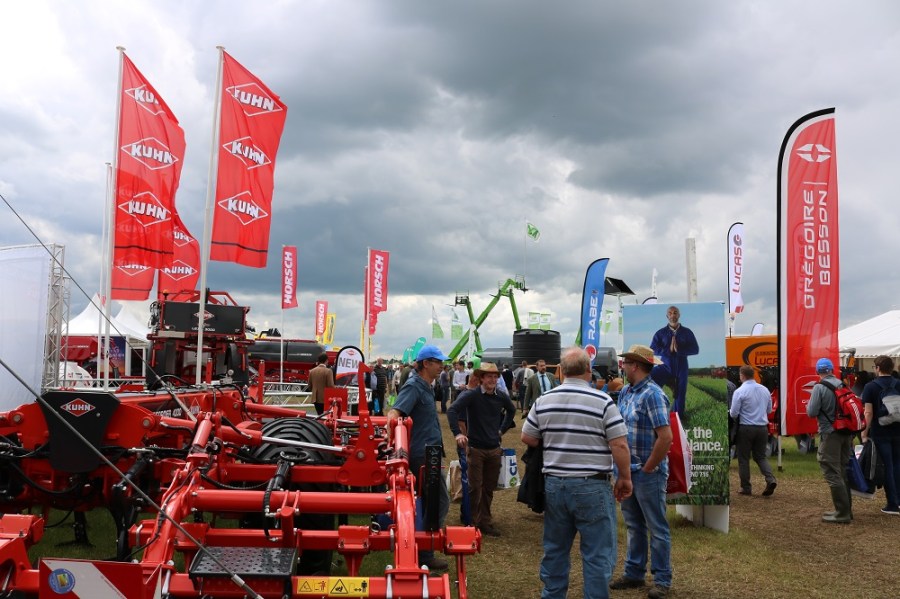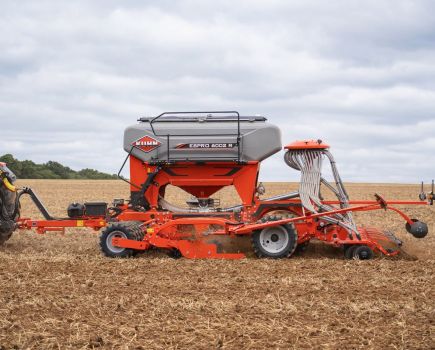While 2016 won’t go down as a vintage Cereals for machinery, visitors were still treated to a surprise sprayer launch as well as a number of other new machines. CPM scoured the machinery lines to find some other interesting developments.
There’s now increasing demand for more capacity.
By Mick Roberts
On the eve of Cereals, Chafer announced its new Interceptor self-propelled sprayer would make its debut on the opening day of the event. This’ll go on sale in spring 2017 and will soon be followed by a smaller, Defender, model.
The Interceptor will be available with 4000 and 5000-litre stainless steel tanks and booms up to 36m, while the Defender offers a capacity choice of 3000 to 3500 litres with booms up to 30m wide. Both are powered by a six-cylinder Deutz engine developing 215hp on the larger model and 180hp on the smaller machine.
The first new fully hydrostatic machines, entirely built and designed in-house by the Grantham-based manufacturer for many years, employ equipment first developed for its latest trailed ranges including ‘e’ plumbing, electronic control and existing boom choices.
One of the most significant advances, says the firm’s Stuart Robertson, is its Bosch Rexroth hydrostatic transmission and wheel motors. While not unique in the industry, it’s still unusual, in using a variable displacement swash plate pump and motors. Final drive to the wheels is through epicyclic gears on the motors.
No throttle
The fully automatic system operates in field or road mode. Interestingly, there’s no throttle – the engine rpm responds to demand through the operator simply pushing the joystick forward or back to change speeds. The transmission responds to supply the oil flow required to match the torque and power demands and engine rpm increases or falls, accordingly.
An inclinometer in the system detects if the machine is climbing a hill and diverts more flow to rear axle to increase the torque. A gyroscope senses when the sprayer is turning and the system responds by slowing the inside wheels and speeding up the outer ones – working like an electronic diff.
Mounting the engine behind the cab over the front axle and the boom above the rear axle provide true 50:50 weight distribution, says Stuart Robertson, regardless of fill level. The tank is designed to keep the centre of gravity low and drains to the centre.
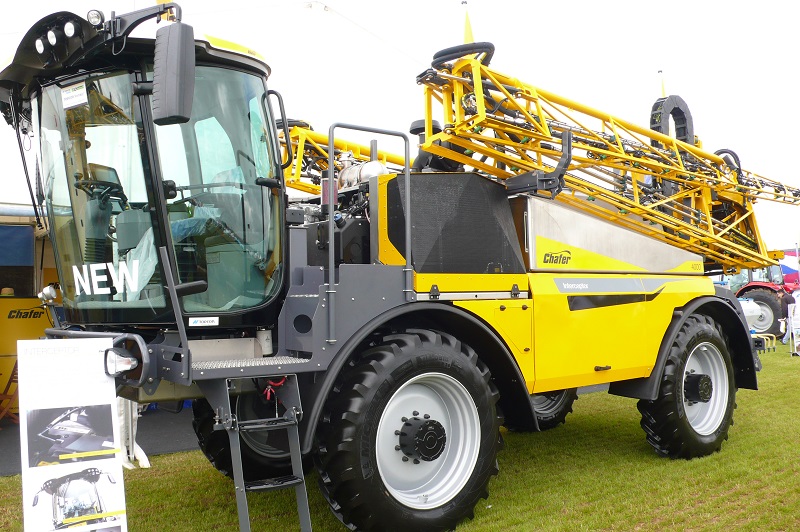
Chafer’s new Interceptor made its debut at Cereals and goes on sale in spring 2017.
There’s a choice of manual, rotary valve spraying control or Chafer’s latest ‘e’ plumbing package, which comes with two terminals – one in the cab and the other by the filling station. The Hypro centrifugal pump delivers up to 500 l/min and a max pressure of 10 bar.
The large, pressurised cab is built by Fritzmeier and is equipped with a New Holland seat.
The new 6000-litre capacity Horizon sprayer, which made its debut at Cereals, is the highest capacity machine made by Norfolk-based manufacturer Sands. While the 5.5 model (5500 litres) has done well, reports Neal Sands, there’s now increasing demand for more capacity.
Although it shares much in common with the 5.5, there’s an uprated chassis to support the load. This is still equipped with self-levelling suspension, which uses four hydraulic rams linked to accumulators providing a choice of ‘ride’ positions.
Suffolk-based Landquip, which introduced the first demount unit for the new JCB Fastrac 4000 Series, has further honed the design with a new 30m boom, which folds vertically behind the machine to a narrow, 2.45m. This keeps it well within the width of the tractor.
The aluminium boom, made by Pommier, is exactly the same as that used on the firm’s Condor machines and the spraying equipment is the same as the existing 2542 model.
Hardi’s completely new Mega mounted sprayer, launched at Agritechnica last year made its UK debut at Cereals. The 1800 or 2200-litre capacity machines are built on a new chassis, which has a new roller/bracket top link system that allows the machine to be close-coupled to the tractor while providing more space to connect the link arms and PTO.
Drill decisions
Meanwhile, away from the Sprays and Sprayers arena, those looking for new or different drills had the opportunity to see new models recently introduced by Kuhn with its Espro and the Horsch Avatar, both of which were making their second Cereals appearance.
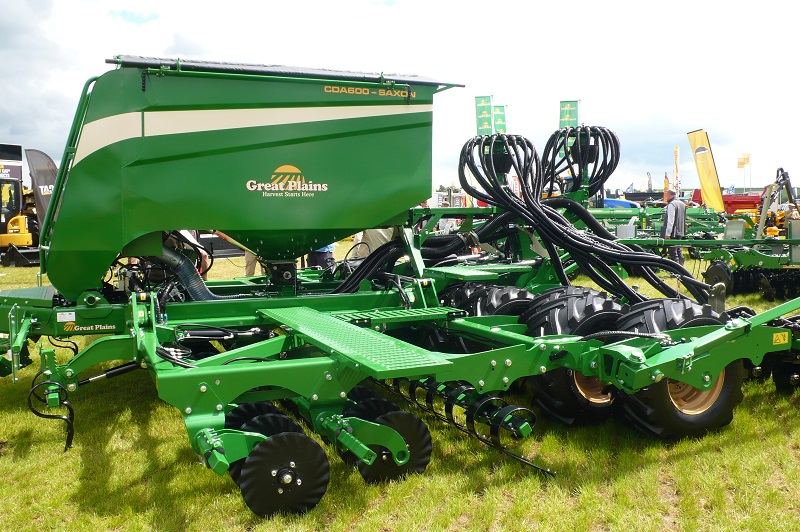
Great Plains has added a new 6m wide grain only version of its Saxon drill, while 3m and 4m versions have grain and fertiliser options.
Great Plains continues to develop its drills using the interesting concept of offering the same base unit as the Centurion equipped with front cultivation elements or as the Saxon for those requiring minimal disturbance from front, vertical discs.
Further developments now see the introduction of a grain and fertiliser option on the 3m and 4m models allowing operators to choose to split the 3000-litre capacity hopper as 60:40 or 50:50 grain to fertiliser. A 4000-litre hopper is an option on the 4m wide models.
A single Crary fan unit supplies air for opener via single venture outlets and two ‘towers’ – one for seed and the other fertiliser. There are two independent metering units, which both provide the facility to vary the rate of each on the move.
Great Plains has also added a new 6m wide grain only version of its Saxon drill. This second generation model has been substantially re-engineered with the biggest change being to the tank area, which no longer has the large plastic shields. Elsewhere the main elements are the same, with the ability to swap cultivation elements, the same staggered profile tyre packer and sowing with the OO openers with press wheel options. The machine won the cultivation and drilling section at the show’s IMMA machinery awards.
KRM has added the choice of double-disc coulter units to its Ares Sola drill for those looking for less disturbance when sowing into min-till or conventional seedbeds. These comprise two 350mm boron flat steel discs, one mounted slightly ahead of the other to create the seed furrow.
A cover over the coulters prevents trash getting in between the discs, while scrapers inside reduce soil build-up in sticky conditions. The disc coulters are mounted on parallelogram linkage that maintains the correct angle for soil penetration, while depth is set by the following rubber control wheel. This is adjusted simply by moving the position of a spring-loaded stop into a range of holes on the bracket.
The double-disc coulters are available for the mounted Ares drill in widths from 4m to 6m and can be used with both the Solo and Integrated Cultivator models.
For those looking to establish cover crops, Pöttinger has introduced its Tegosem that can be fitted to its Terradisc disc harrows as well as the Synkro stubble cultivators. With this new unit designed specifically for these machines, says the firm, it allows dealers and customers to fit the applicator quickly and easily without having to resort to constructing brackets and other ‘custom’ arrangements.
Electrically driven
The Tegosem comes with two cell wheels for the electrically driven metering unit. A sensor on the top link stops and starts the sowing automatically when the implement is raised and lowered. The seed delivery fan is driven either electrically or hydraulically, depending on width.
Operation is by a simple terminal in the cab, which monitors the seed shaft-speed and adjusts the seed rate, displaying this on the screen as well as providing automatic calibration.
Dale Drills’ Eco-XL direct drill has a new following harrow that can be equipped with two rows of tines. The attachment is available in all working widths and creates a more level surface after the drill has passed, says the Lincs-based manufacturer, as well as a better distribution of crop residues.
You can drop one row of tines if necessary, or leave the attachment completely lifted out of work. The angle of the tines is adjustable using a pin-and-hole system with 10 different positions.
The Eco-XL comes with a new link-arm drawbar, meaning you can hitch on to the drill using the lower link arms of the tractor. A new deeper tine option is also available for all drills, which can be set to run three inches below where the seed is placed to create a drainage channel and loosen the root zone for ‘lazier’ rooting crops such as oilseed rape.
Tantalising tractors
A visit to Cereals wouldn’t be complete without a chance to drool over big tractors and showgoers weren’t disappointed. Case IH’s Quadtrac 620 had many reaching for their cameras. The tractor has received a few tweaks recently including improvements to the hydraulic valves and system that control the speed the transmission shifts, making it smoother and faster.
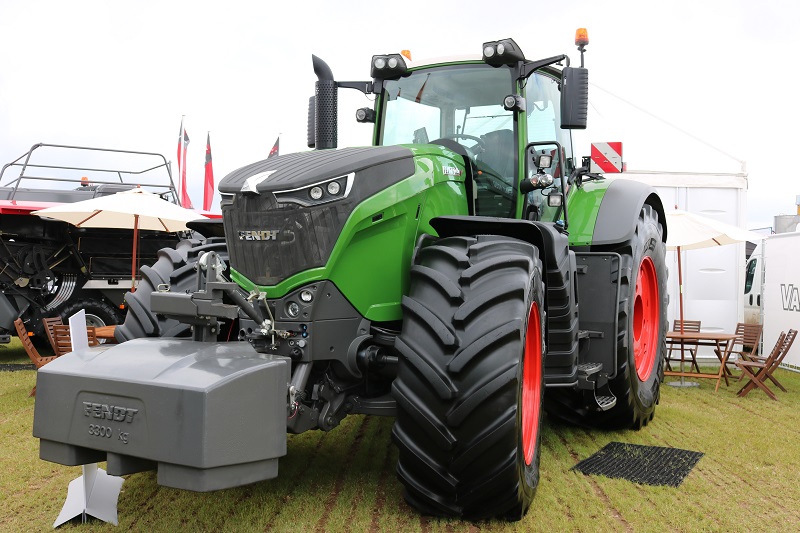 But it was Fendt’s 1050 Vario that was probably the winner of the tractor ‘selfie’ stakes, with numerous, admitted young males, stopping to pose with the monster. Any doubts about whether there’s a market for a wheeled, not tracked, 500hp tractor are quashed by the news that the UK’s allocation of ten tractors have all been sold.
But it was Fendt’s 1050 Vario that was probably the winner of the tractor ‘selfie’ stakes, with numerous, admitted young males, stopping to pose with the monster. Any doubts about whether there’s a market for a wheeled, not tracked, 500hp tractor are quashed by the news that the UK’s allocation of ten tractors have all been sold.
At the other end of the arable range, Kubota introduced the newest models of its M7001 Series of tractors aimed at crop producers. Available in three options, the Standard and Premium models feature a powershift transmission while the Premium KVT is a CVT. Fitted with a V6108 engine, the orange-liveried tractors sit in the 135-175hp range.
Earthmoving invention
An interesting development, the Lland-Ho Earthwake caused many visitors to stop and scratch their heads trying to discover what looked like a large auger mounted in a frame could be used for. Inventor, Ross Holland, explains it’s for creating shallow water diversion channels across the tramlines, staggered every 2m across tramlines.
In his role working for a water company, he realised there’s a need for a simple tool to prevent water running off across fields and causing erosion while also polluting water courses with soil and possible pesticide residues. Judging by the interest shown by farmers, it’s something that concerns not just Ross Holland.
The simple design, which cuts slots in cultivated fields and even in growing crops up to GS30, creates the small channels that capture the water and reducing its energy, velocity and build up – conditions that can cause erosion.
Box-clever biobed
A small blue metal box about the size of an IBC was hardly the most eye-catching display, but it may contain the answer for those looking at ways to dispose of sprayer washings. The Sentinal was probably a bit ahead of its time when launched in 1982, but has been used very successfully to clean washings on research stations and large industrial enterprises across the world.
Now this scaled-down version is attracting interest from large farmers and contractors who are looking at an alternative to biobeds or bio stacks to process large volumes of washings safely and easily.
The latest model costs £7250 and handles 350 litres in batches in about 4 hours. The resulting effluent can be disposed of in the normal way with the proper exemption or, says the makers, is so clean it could even be stored and used again in the sprayer for less sensitive applications such as glyphosate.
The Sentinal first uses a chemical pre-treatment to break the ‘bond’ between the chemical and the water before further processing including pH correction and carbon filtering.
Systems are available to treat batches from 100 to 2000 litres in two to seven hours.

